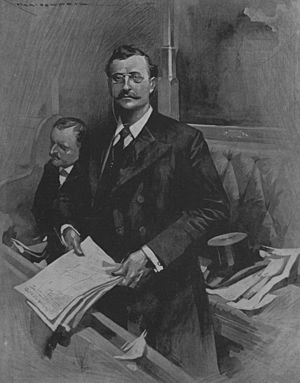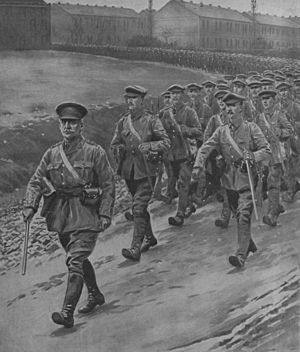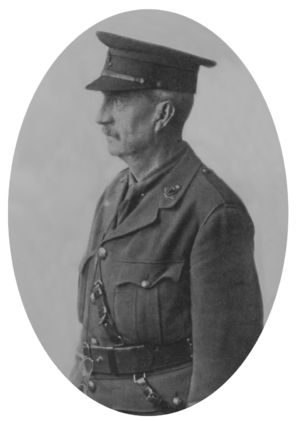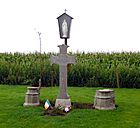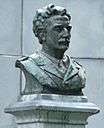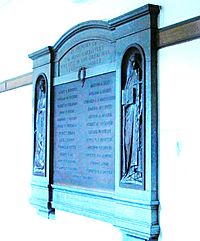Willie Redmond facts for kids
Quick facts for kids
Willie Redmond
|
|
|---|---|
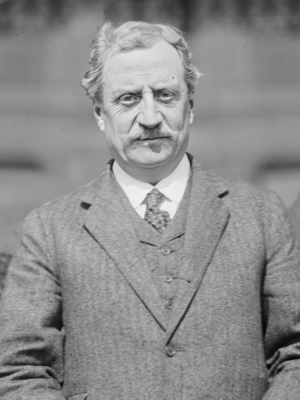
Redmond in 1912
|
|
| Member of Parliament | |
| In office 1883-1885, 1885-1892, 1892-1917 |
|
| Personal details | |
| Born | 13 April 1861 Ballytrent, County Wexford, Ireland |
| Died | 7 June 1917 (aged 56) Messines, Belgium |
| Relations | William Redmond (father), John Redmond (brother) |
| Military service | |
| Allegiance | |
| Branch/service | |
| Years of service | 1879-1881, 1915-1917 |
| Rank | Major |
| Commands | Royal Irish Regiment |
| Battles/wars | World War I |
William Hoey Kearney Redmond (born April 13, 1861 – died June 7, 1917) was an important Irish politician and soldier. He was known for supporting Irish independence and served as a Member of Parliament (MP). He was also a lawyer and fought in World War I, where he sadly lost his life.
Contents
- Who Was Willie Redmond?
- Fighting for Land Rights in Ireland
- Willie Redmond's Political Work
- Standing Up for His Beliefs
- Willie Redmond and World War I
- The Battle of Messines Ridge
- Willie Redmond's Death
- Willie Redmond's Grave
- Images for kids
- Remembering Willie Redmond
- Willie Redmond's Books
- War Memorials for Irish Soldiers
Who Was Willie Redmond?
Willie Redmond came from a well-known Catholic family in County Wexford, Ireland. His family had been in the area for over 700 years. His father, William Redmond, was also an MP who supported Home Rule for Ireland. Willie's older brother, John Redmond, became a very important leader of the Irish Parliamentary Party.
Willie's Early Life and School
Willie grew up in Ballytrent, County Wexford. He went to school at Clongowes Wood College and other schools like Knockbeg College. After school, he first worked on a merchant ship. Then, he joined the local army group, the Royal Irish Regiment, in 1879. He thought about becoming a full-time soldier but decided to leave the army in 1881.
Fighting for Land Rights in Ireland
After leaving the army, Willie joined Charles Stewart Parnell and the Irish National Land League. This group worked to help farmers get fair land rights. In 1882, Willie was arrested and put in Kilmainham Gaol prison in Dublin. He was in prison with Parnell and other leaders. Willie always stayed loyal to Parnell, even when things got tough for him later on.
Traveling to Raise Money
In 1882, Willie traveled to the United States with Michael Davitt to collect money for the Land League. The next year, he and his brother John went to Australia. They raised a lot of money, about £15,000, for the cause of Irish independence. They also met two sisters from a rich family, the Daltons, who later became their wives. After Australia, they went back to the United States and raised even more money.
Becoming an MP
While he was away, Willie was elected as an MP for his father's old area, Wexford Borough, in 1883. He then became an MP for Fermanagh North in 1885. Being an MP in Ulster, a part of Ireland with many Protestants, made him hope that Protestants and Catholics could work together for Irish self-rule. He believed this unity could even be formed during the war.
Willie often got into trouble with the police during the Land League protests. He was even sent to prison for three months in 1888 for trying to stop a farmer from being evicted from his home.
Willie Redmond's Political Work
Willie Redmond strongly believed in Home Rule for Ireland, just like his father. Home Rule meant that Ireland would have its own government to make decisions, instead of being fully ruled by Britain. He felt that British rule had harmed Ireland by reducing its population, causing arguments between different groups, and hurting its businesses.
A Lively Politician
Willie was a very energetic and open politician. He was known for being enthusiastic and sincere. People liked him because he was brave and always ready to fight for what he believed in. He would never ask others to do something he wasn't willing to do himself. He was sometimes called the "enfant terrible" (a mischievous person) of Irish politics because he was often thrown out of the House of Commons for speaking too loudly or getting into arguments with other MPs. Even so, many people, even his opponents, liked him.
Supporting Parnell and Changing Areas
When the Irish Party split after Parnell's death in 1891, Willie strongly supported Parnell. He was very upset that the Church seemed to be against Parnell. Because of this, he had to change the area he represented from Fermanagh to Clare. In 1892, he was elected MP for East Clare and continued to be elected without opposition until he died in 1917. He worked hard to keep Irish people united.
In 1886, he married Eleanor Mary Dalton. They had one son who sadly died young in 1891. Willie became a lawyer in 1891 but never worked as one. For most of his early career, he received money from the Irish Parliamentary Party. MPs only started getting a regular salary in 1911.
Standing Up for His Beliefs
Willie Redmond spoke out against the Boer War in South Africa in 1899. He joined younger Irish nationalists like Arthur Griffith. He also supported women's right to vote, which was a very modern idea at the time. A military friend described him as a "charming fellow with a gentle and very taking manner."
In 1902, he was imprisoned again for a speech that caused "social discord." He was also a strict non-drinker but loved to smoke. He spent a lot of time trying to encourage tobacco farming in Ireland. He traveled widely, visiting Irish communities around the world. He was impressed by how countries like Canada and Australia governed themselves. This made him even more passionate about Ireland having its own self-government.
When the third Home Rule Act 1914 was passed in 1914, it made him sad that some Irish groups didn't support it. When the Irish Volunteer Movement was recognized, he joined with all his heart. He even went on a dangerous trip to Brussels to get weapons for the Volunteers.
Willie Redmond and World War I
When World War I started in August 1914, Willie's brother, John Redmond, asked Irish Volunteers to join the British army. He hoped this would help the cause of Home Rule after the war. Willie Redmond was one of the first to volunteer. He gave speeches encouraging Irishmen to join the war effort, believing it would help Ireland.
In November 1914, he gave a famous speech in Cork. He said that even though his family had suffered under British rule, he believed the "battle of Ireland" was now being fought in places like Flanders and France. He told young Irishmen, "Don't go, but come with me," meaning he would join them in fighting. He felt that if Germany won the war, Ireland would be in danger. Willie was one of five Irish MPs who fought in the British army.
His Time as a Soldier
Willie Redmond became a captain in the 6th Royal Irish Regiment in February 1915, even though he was 53 years old. He went to the Western Front in France with the 16th (Irish) Division, which was made up of Irish volunteer soldiers. He was a brave leader and was even mentioned in official reports for his good work. He refused to ride a horse and always marched with his men, carrying his own pack.
Willie strongly believed that fighting together in the trenches was bringing Irish Protestants and Catholics closer. He thought it was helping them overcome their differences. In 1916, he told his friend Arthur Conan Doyle that building a bridge between North and South Ireland over the graves of fallen soldiers would be a great memorial.
The Easter Rising in 1916, an uprising in Dublin, deeply upset him. He felt it would ruin his hopes for Irish unity and lead to Ireland being divided. He was promoted to Major in July 1916, but his health suffered, and he had to leave the front lines for a while.
When he was on leave in March 1917, he gave his last speech in Parliament. He defended Ireland's involvement in the war and asked the British government to bring in the Home Rule Act right away. He saw the war as a chance to bring all Irish people together.
The Battle of Messines Ridge
Willie Redmond was sent back to the front lines by his commander, Major-General Hickie. He wrote to a friend, "My men are splendid and we are pulling famously with the Ulstermen. Would to God we could bring this spirit back to Ireland. I shall never regret I have been out here." Just before his death, he gave a speech where he "prayed for peace between North and South."
During preparations for the Battle of Messines in Belgium, 56-year-old Willie got special permission to rejoin his battalion. The night before the attack on June 7, 1917, he visited every man in his company. He had told a friend he had a feeling he was "going back to get killed." He truly believed that fighting together would help Irish Protestants accept Home Rule.
Willie Redmond's Death
On June 7, 1917, Irish soldiers from the 16th and 36th Divisions attacked the Messines Ridge. Willie Redmond was one of the first to lead his men out of the trenches. He was hit by German fire almost immediately in the wrist and then in the leg. He fell but urged his men to keep going. Stretcher bearers from the 36th (Ulster) Division, including a wounded soldier named Private John Meeke, carried him back to safety. He was taken to a hospital in Locre, Belgium, where he died from his wounds later that afternoon.
News of his death was reported in almost all newspapers in Britain and Ireland. His wife and brother received over 400 messages of sympathy. Important figures like Unionist MP Sir Edward Carson and poet Francis Ledwidge honored his memory. The French Government even gave him a special award, the Legion of Honour, after his death. His death had a huge impact around the world.
Willie Redmond's Grave
Willie Redmond was buried in a special grave in the garden of the convent at Locre, Belgium, on June 8, 1917. Soldiers from both the 16th (Irish) Division and the 36th (Ulster) Division (Protestant and Catholic Irish soldiers) formed his Guard of Honour, as he had wished. The men of the 36th (Ulster) Division even donated money for a memorial fund for him.
In 1919, his wife, Eleanor, visited his grave and was happy with how well the nuns at Locre had cared for it. When the War Graves Commission wanted to move his body to a larger cemetery, Eleanor asked them to leave him where he was, in the care of the nuns.
Willie Redmond was seen as a "Grand Old Man" of the Irish Division. His lonely grave became a symbol of how complicated and unclear Ireland's feelings were about its sons who fought in World War I.
Images for kids
Remembering Willie Redmond
Willie Redmond is remembered on a special memorial in Westminster Hall in London, which lists MPs who died in World War I. His name is also on shields in the Commons Chamber. In 1932, a special book was created for the House of Commons that tells a short story of his life and death.
The people of Loker, Belgium, still care for his grave with great respect. They have held ceremonies to remember him and have refused to let his grave be moved. There is even an "Irish" pub in Loker named Redmond's Bar after him.
In 1944, Winston Churchill spoke about Willie Redmond, calling him a "gallant figure" and wondering if a chance for unity had been missed in Ireland.
In the town of Wexford, Ireland, there is a statue of Willie Redmond in Redmond Park. The park was opened in his memory in 1931.
In 2013, the Prime Ministers of Ireland, Enda Kenny, and the United Kingdom, David Cameron, visited his grave and paid tribute to him. Kenny said that standing at Redmond's grave made him think about why the European Union exists. Both leaders also visited other memorials in Belgium that honor the Irish who died in the Great War. Kenny visited his grave again in 2017 on the 100th anniversary of his death.
Willie Redmond's Books
- W. H. K. Redmond, A Shooting trip to the Australian bush (1898)
- W. H. K. Redmond, Through the New Commonwealth, Dublin, 1906
- William Hoey Kearney Redmond, Trench pictures from France, A. Melrose, 1917
War Memorials for Irish Soldiers
- Irish National War Memorial Gardens, Dublin.
- Island of Ireland Peace Park Messines, Belgium.
- Menin Gate Memorial Ypres, Belgium.


